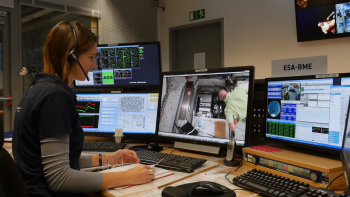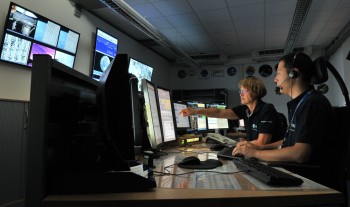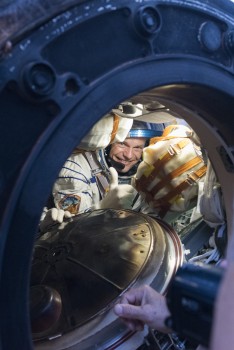With the London Marathon rapidly approaching it is time to introduce the hard-working team that supports Tim during his time in space. Based at the European Astronaut Centre in Cologne, Germany, a number of people assure that Tim stays healthy. His attempt to run a marathon on the International Space Station’s treadmill means that his fitness programme and diet has been adapted to ensure he will return to Earth in full health – and complete the 42 km run. We asked the team some questions to introduce themselves:
What is your working title?
ESA Biomedical Engineer Mission Manager
What do you do?
It is our responsibility to integrate all medical requirements for Tim Peake into his timeline. We coordinate between Surgeons, Exercise Specialists, Physiologists, Psychologists and specialists in radiation, microbiology, toxicology, nutrition and optometry to ensure Tim stays health and his environment is safe.
What does your typical day look like?
Our job involves looking ahead. What is the next medical test to be scheduled? What experiments is Tim performing that could have an impact on his health or be in conflict with his countermeasure regime? We anticipate potential challenges in the plan or with medical hardware and coordinate with our counterparts in Munich, Houston, Star City and around the world to minimise impacts to the crew.
How is working for Tim Peake and ESA?
Working on the Principia mission has been a lot of fun. The first couple months were extremely busy with unplanned spacewalks, Tim’s own spacewalk and preparing for visiting vehicles. After that, the team quickly hit its stride and now Medical Operations “Med Ops” is gearing up to support Tim as he attempts to complete the London Marathon on the International Space Station using a modified treadmill.
How have you adapted to Tim’s marathon run?
A lot of coordination was required leading up to the marathon. Our exercise specialists provided us with a proposed plan for how they would recommend maintaining Tim’s fitness and include more endurance training to prepare him for the many hours running on a modified treadmill. We also consulted with the surgeons and nutritionists to determine if there was a need to change his standardised diet. We brainstormed how to combat the pressure points and discomfort of using a harness to keep Tim connected to the treadmill while he runs. We then solicited the Engineering Team of the Treadmill 2 (called T2 for short) to determine if it could support a continuous run of up to six hours – even though Tim is planning in completing the marathon in around four hours. We analysed the need for additional maintenance on the treadmill on account of the additional training sessions required. We analysed the vibration isolation system to be sure we wouldn’t impart structural loads to the Space Station. Finally we reviewed all the physiological experiments Tim will be performing and communicated the expected change in training from our standard strategy so that we would not influence important science experiments.
What is the best part of your job?
The best part of the job is watching the astronauts smile after leaving the Soyuz capsule upon return. There are few other industries you can work on an international scale in a truly collaborative setting. The medical community is one of the best at this integration and cooperation. At landing you see Russian, US and ESA medical teams working together and the astronaut’s smile means we successfully did our job of returning the crewmember in the best state of health possible.
Anything else?
Space Station astronauts can send emails and make phone calls. We’re very happy to have received both, providing us feedback on our support and telling us that our job is making a difference. We also have photos of us that flew into space framed in our living rooms – these are small gestures that make up for the countless hours of work that go into a mission.




Discussion: 3 comments
Congratulations on all your hard work helping Tim Peake, our Astronaut through his Mission and preparing for the London Marathon. This really has been altitude training (smile) that could impact the body. Am guessing you will have specific times that you will remind Tim to re-hydrate himself whilst running the Marathon? Will he be drinking water or some other energizing liquid? What is the vibration isolation system please? I know somebody who has a BSc Sports Science qualification and so am showing them your article, a great job for you, well done.
Hi Pam,
thanks for your great questions!
For the first two questions regarding Tim’s hydration: Tim is a very experienced runner, therefore it is not required to remind him of his hydration, he will be able to control it by himself. For the kind of drinks: We did not send up isotonic drinks for the London Marathon event.
As an engineer I’m happy to answer your question about the vibration isolation system (VIS):
Running creates big loads. Running on the ISS Treadmill (called “T2”) can actually create such big loads that the whole space station could begin to oscillate without a vibration isolation system. And what we certainly don’t want to see is an oscillating Space Station. Not only that this would break microgravity requirements of dozens of experiments, it would degrade the Space Station’s structural life expectation. That’s why T2 has a vibration isolation system consisting of a sequence of springs and dampers to prevent imparting its loads to the ISS Structure. The overall goal is that the treadmill is moving while running on it – and not the ISS. NASA Astronaut Karen Nyberg was onboard ISS together with ESA Astronaut Luca Parmitano as Expedition 36 & 37 crewmembers. She recorded this video of her running on T2, have a look how the treadmill is wobbling!
https://www.youtube.com/watch?v=_ikouWcXhd0
Hi Tim Irawan…Many thanks for taking the time to answer my questions. Yes, I can see what you mean, Tim Peake will be able to regulate his fluid intakes. I didn’t realize about the massive effects that the Treadmill, and maybe other training equipment would have on the Space Station. Thanks for explaining this. There is so much for everybody involved to think about re Space Station and Space travel, it must be endless. I did see how the treadmill wobbled as Karen Nyberg, Astronaut ran. The more I have been finding out about the Mission, the more remarkable it all is, much appreciated for this explanation 🙂